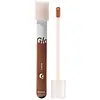What's inside
What's inside
 Key Ingredients
Key Ingredients

 Benefits
Benefits

 Concerns
Concerns

 Ingredients Side-by-side
Ingredients Side-by-side

Mica
Cosmetic ColorantTalc
AbrasiveCI 77891
Cosmetic ColorantSynthetic Fluorphlogopite
Calcium Titanium Borosilicate
AbrasiveDiisostearyl Malate
EmollientSilica
AbrasiveAluminum Starch Octenylsuccinate
AbsorbentHydrogenated Polyisobutene
EmollientPhenyl Trimethicone
Skin ConditioningDipentaerythrityl Hexahydroxystearate/Hexastearate/Hexarosinate
Skin ConditioningMagnesium Stearate
Cosmetic Colorant1,2-Hexanediol
Skin ConditioningDimethicone
EmollientGlyceryl Caprylate
EmollientCI 77491
Cosmetic ColorantTin Oxide
AbrasiveCI 73360
Cosmetic ColorantCI 77492
Cosmetic ColorantCI 19140
Cosmetic ColorantCI 77499
Cosmetic ColorantTriethoxycaprylylsilane
Mica, Talc, CI 77891, Synthetic Fluorphlogopite, Calcium Titanium Borosilicate, Diisostearyl Malate, Silica, Aluminum Starch Octenylsuccinate, Hydrogenated Polyisobutene, Phenyl Trimethicone, Dipentaerythrityl Hexahydroxystearate/Hexastearate/Hexarosinate, Magnesium Stearate, 1,2-Hexanediol, Dimethicone, Glyceryl Caprylate, CI 77491, Tin Oxide, CI 73360, CI 77492, CI 19140, CI 77499, Triethoxycaprylylsilane
Isododecane
EmollientMica
Cosmetic ColorantTrimethylsiloxysilicate
EmollientAluminum Starch Octenylsuccinate
AbsorbentDiisostearyl Malate
EmollientHydrogenated Styrene/Isoprene Copolymer
Disteardimonium Hectorite
StabilisingPolyethylene
AbrasiveTrihydroxystearin
Skin ConditioningSynthetic Fluorphlogopite
Polymethylsilsesquioxane
Silica
AbrasivePropylene Carbonate
SolventLauroyl Lysine
Skin ConditioningPentaerythrityl Tetra-Di-T-Butyl Hydroxyhydrocinnamate
AntioxidantAluminum Calcium Sodium Silicate
Tin Oxide
AbrasiveCI 77891
Cosmetic ColorantIron Oxides
CI 77000
Cosmetic ColorantIsododecane, Mica, Trimethylsiloxysilicate, Aluminum Starch Octenylsuccinate, Diisostearyl Malate, Hydrogenated Styrene/Isoprene Copolymer, Disteardimonium Hectorite, Polyethylene, Trihydroxystearin, Synthetic Fluorphlogopite, Polymethylsilsesquioxane, Silica, Propylene Carbonate, Lauroyl Lysine, Pentaerythrityl Tetra-Di-T-Butyl Hydroxyhydrocinnamate, Aluminum Calcium Sodium Silicate, Tin Oxide, CI 77891, Iron Oxides, CI 77000
Ingredients Explained
These ingredients are found in both products.
Ingredients higher up in an ingredient list are typically present in a larger amount.
Aluminum Starch Octenylsuccinate is a synthetic powder used as an absorbent, thickener, and anti-caking agent.
As an absorbent, it is great at mattifying skin by soaking up the oil. This is why you'll find it in a range of products from makeup to moisturizers.
This ingredient is considered a modified starch. Starch can also be found naturally in plants.
One study from 1991 found that 5% of this ingredient enhanced titanium dioxide SPF by as much as 40%. The study found 1% titanium dioxide had a 5.6 SPF and adding 5% of aluminum starch octenylsuccinate boosted it to an SPF of 8.1
Although “aluminum” in an ingredient name can raise red flags for some consumers, the form and usage context matter significantly. For typical topical applications, there is no substantial evidence of health risks - such as cancer, neurotoxicity, or systemic “aluminum overload.”
Learn more about Aluminum Starch OctenylsuccinateCi 77891 is a white pigment from Titanium dioxide. It is naturally found in minerals such as rutile and ilmenite.
It's main function is to add a white color to cosmetics. It can also be mixed with other colors to create different shades.
Ci 77891 is commonly found in sunscreens due to its ability to block UV rays.
Learn more about CI 77891Diisostearyl Malate is an emollient and most often used in lip products. It comes from isostearyl alcohol, a fatty acid, and malic acid, an AHA.
As an emollient, Diisostearyl Malate helps create a thin film on your skin to trap moisture in. This helps keep your skin soft and smooth.
Mica is a naturally occurring mineral used to add shimmer and color in cosmetics. It can also help improve the texture of a product or give it an opaque, white/silver color.
Serecite is the name for very fine but ragged grains of mica.
This ingredient is often coated with metal oxides like titanium dioxide. Trace amounts of heavy metals may be found in mica, but these metals are not harmful in our personal products.
Mica has been used since prehistoric times throughout the world. Ancient Egyptian, Indian, Greek, Roman, Aztec, and Chinese civilizations have used mica.
Learn more about MicaSilica, also known as silicon dioxide, is a naturally occurring mineral. It is used as a fine, spherical, and porous powder in cosmetics.
Though it has exfoliant properties, the function of silica varies depending on the product.
The unique structure of silica enhances the spreadability and adds smoothness, making it a great texture enhancer.
It is also used as an active carrier, emulsifier, and mattifier due to its ability to absorb excess oil.
In some products, tiny microneedles called spicules are made from silica or hydrolyzed sponge. When you rub them in, they lightly polish away dead skin layers and enhance the penetration of active ingredients.
Learn more about SilicaSynthetic Fluorphlogopite is the synthethic version of mica. It consists of fluorine, aluminum and silicate.
Synthetic Fluorphlogopite is used to add volume to products.
It is considered non-irritating on the skin.
Learn more about Synthetic FluorphlogopiteTin Oxide is an inorganic oxide used to add opacity and volume to a product. In nature, it is already found in mineral form. The main ore of tin is an opaque and shiny mineral called casseterite.
Tin Oxide helps remove translucency in a product, or make it more opaque. Besides adding opacity, tin oxide is used for bulking to add volume.